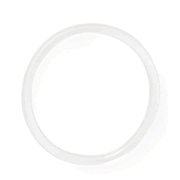- Birth control
- Birth control ring
Birth control ring

What is the birth control ring?
The birth control ring (brand names: Annovera and NuvaRing) is a small, bendable plastic ring that you insert into your vagina. You leave it in place for three weeks at a time, then take it out for the fourth week. The main way the ring works is by giving off hormones that prevent your ovaries from releasing eggs.
There are two types of birth control rings, one that you can use over and over for up to a year (Annovera) and one type that is replaced monthly (NuvaRing or its generic versions).
Quick Facts
-
Effectiveness
The ring is very effective the way most people use it.
Perfect use: 97 to over 99% effective
Typical use: 93% effective
What are perfect use and typical use?
-
Hormones
The ring contains two different kinds of hormones, estrogen and progestin.
-
Side effects
Most common—but usually temporary—side effects are irregular bleeding, headaches, sore breasts, and nausea.
-
Cost
Anywhere from $0 (with insurance) to $200 a month.
-
STI protection
The ring doesn’t protect against STIs.
-
Ongoing effort
Ring in. Wait 3 weeks. Ring out. Wait 1 week. Repeat. Get a new ring every month.
Types of birth control rings

Yearly birth control ring (Annovera)
Annovera is a birth control ring that you can use for up to a year. You place it inside your vagina, leave it there for three weeks, then take it out and leave it out for one week, which is usually when you’ll have a withdrawal bleed (similar to a period). During this time you store it in its own little case. Then you put it back in for the next cycle.

Monthly birth control ring (NuvaRing)
The NuvaRing is a birth control ring that you replace monthly. Just like with Annovera, you put it inside your vagina, leave it there for three weeks, then take it out and don’t put a new one in for one week, which is usually when you’ll have a withdrawal bleed (similar to a period). At the end of that week, you insert a new ring.

We can help you find an in person provider or online birth control delivery service.
find health care